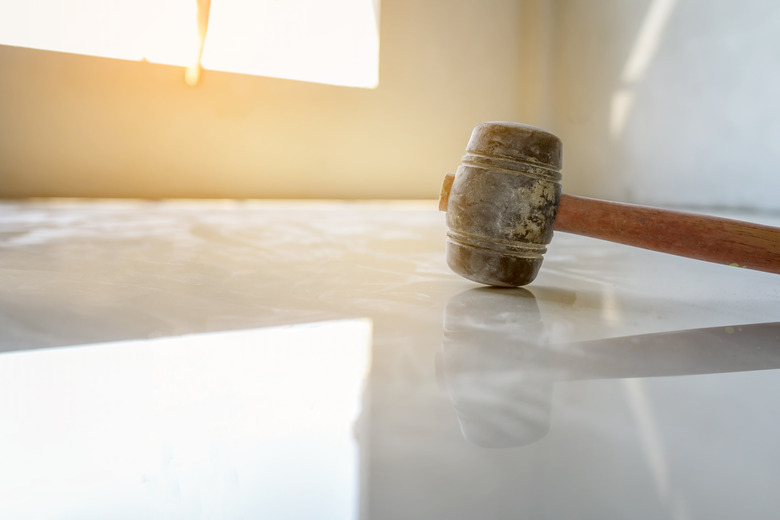The Effects Of High Temperature On Epoxy
Epoxies are polymer chemicals that cure into hard surfaces. Epoxy may be used as part of glues or as coatings for surfaces. Epoxy is lightweight, anti-corrosive and possesses other useful mechanical qualities that make it a valuable material for use in aircraft, automobiles, construction, concrete surface repair, hydropower structure reinforcement and electronic devices. Epoxy resins work well as bonding agents for metals, wood, plastics and other materials. While epoxy remains durable under most everyday conditions, degradation of its polymer matrix can occur due to high heat and heat combined with moisture.
TL;DR (Too Long; Didn't Read)
Epoxy is used in many modern aircraft, vehicles, structures and electronic devices. While epoxy on its own degrades with high temperature and humidity, modern coatings and mixtures help it withstand extreme heat.
High-Heat Effects
High-Heat Effects
Many epoxies retain their durable qualities such as fracture toughness from low temperatures, when they are hardest, to room temperatures. The viscoelastic properties of epoxy, however, become apparent with the introduction of high heat. The temperature at which heat distortion occurs ranges between 20 and 90 degrees Celsius (68–195 F). As temperature increases, a significant amount of the flexural and compressive strength of epoxy decreases. When the temperature increases to 60 degrees Celsius, epoxy reaches the Heat Distortion Temperature (HDT), and it begins to deform. The HDT of an epoxy correlates to its glass transition temperature. The continued increase in temperatures to 90 degrees C leads to more ductile behavior. The temperature increase also leads to loss of load-bearing capacity and stiffness. Epoxies, therefore, are susceptible to temperature increases.
Temperature and Humidity Effects
Temperature and Humidity Effects
Environmental exposure of epoxy-based materials leads to their degradation. Ultraviolet radiation, moisture and temperature all play a role in breaking down an epoxy's matrix. When that occurs, the epoxy loses its useful mechanical properties such as flexural strength. Even at room temperature with 95 percent relative humidity, epoxy plasticizes and swells, and this increases with temperature. In moderate temperatures and low relative humidity, epoxy remains steadfast. The reason for this effect is that polymer composites absorb moisture from the air. The amount of moisture absorption that affects epoxies depends on which hardener is used and how the epoxy is cured. At high temperatures, the process of plasticization proceeds much more rapidly. Low humidity allows for cross-linking, which improves the mechanical properties of the epoxy.
Modern Epoxy Composite Qualities
Modern Epoxy Composite Qualities
Despite these issues, modern epoxies can be strengthened by the addition of certain curing agents to withstand high temperatures. Epoxy resins with a rod structure tend to withstand temperature extremes better than those with structures that are flexible. Epoxy resins with bromine atoms exhibit flame-retardant capability. Carbon fiber-reinforced epoxy composites can withstand significantly high heat (as high as 1500 degrees Celsius), making them valuable for aircraft components. Coatings such as titanium provide a barrier to heat and humidity and extend the lifetime of the epoxy materials.
References
- Centers for Disease Control and Prevention: Reproductive Health and the Workplace: Epoxies and Resins
- Scielo: Effect of Temperature on the Mechanical Properties of Polymer Mortars
- Journal of Composite Materials: Aging by Moisture and/or Temperature of Epoxy/SiC Composites
- Thermochimica Acta: Thermal Properties of High Refractive Index Epoxy Resin System
Cite This Article
MLA
Hermance, Dianne. "The Effects Of High Temperature On Epoxy" sciencing.com, https://www.sciencing.com/effects-high-temperature-epoxy-8590977/. 19 May 2018.
APA
Hermance, Dianne. (2018, May 19). The Effects Of High Temperature On Epoxy. sciencing.com. Retrieved from https://www.sciencing.com/effects-high-temperature-epoxy-8590977/
Chicago
Hermance, Dianne. The Effects Of High Temperature On Epoxy last modified March 24, 2022. https://www.sciencing.com/effects-high-temperature-epoxy-8590977/
